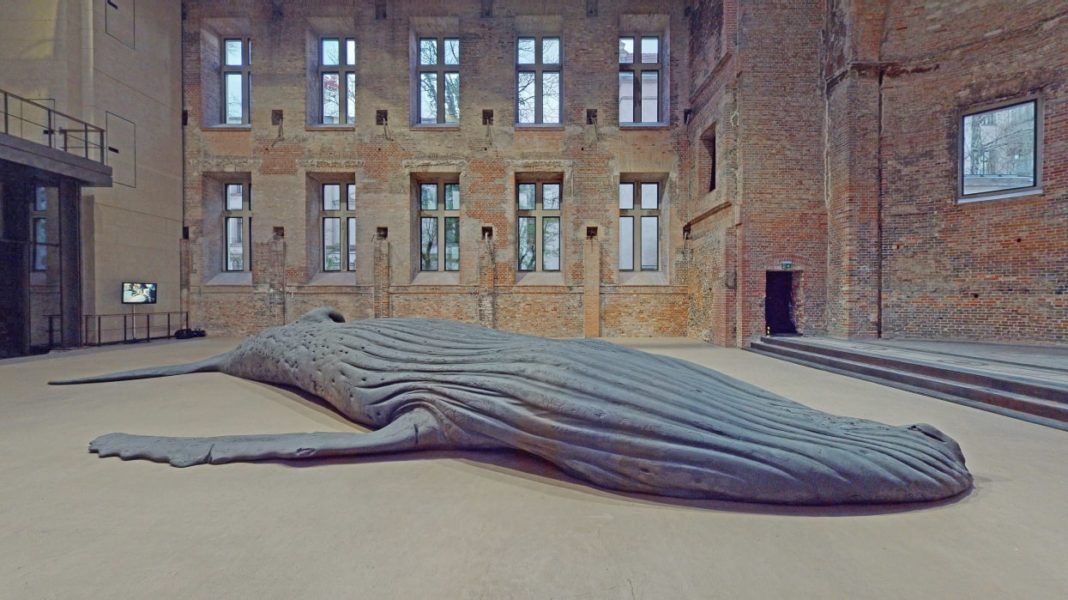Despite a possible lockdown, the exhibition project “The Cast Whale Project” with a life-size, 14 m long whale sculpture by the Israeli artist Gil Shachar, who lives in Germany, will still be open to visitors. The whale will be “stranded” in the St. Elisabeth Church in Berlin-Mitte on the occasion of Gallery Weekend 2021 and can be visited daily from 22nd April (11 a.m. to 8 p.m.) until 14 May 2021 (admission free of charge, FFP 2 mask obligatory, limited to 50 people in the nave at a time). The project was realised on the initiative of the gallery Semjon Contemporary, which represents the artist Gil Shachar.
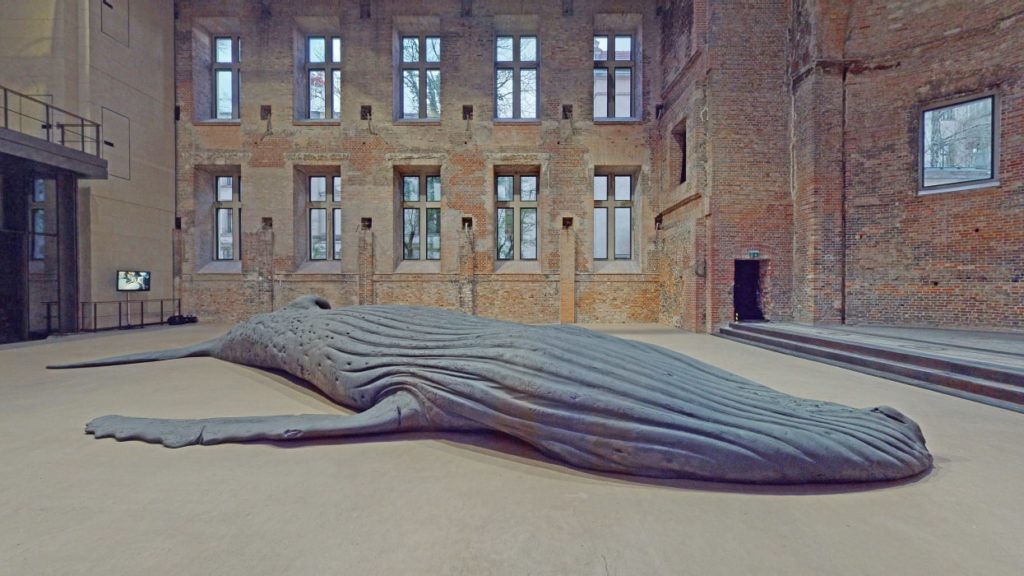
Photo: Artland, Sarah Kivi, by courtesy of the artist and Semjon Contemporary
After years of research, which began in 2013, Gil Shachar received permission from the South African Department of Environmental Affairs to mould a dead humpback whale for an art project. For this purpose, the artist had assembled a team on site that was ready to be called up and that would immediately begin securing and moulding a dead stranded animal after the artist’s “go”.
After a two-year wait, a beached whale suitable for the cast was discovered in Lamberts Bay in August 2018, lying on its back, and was allowed to be used for the art project.
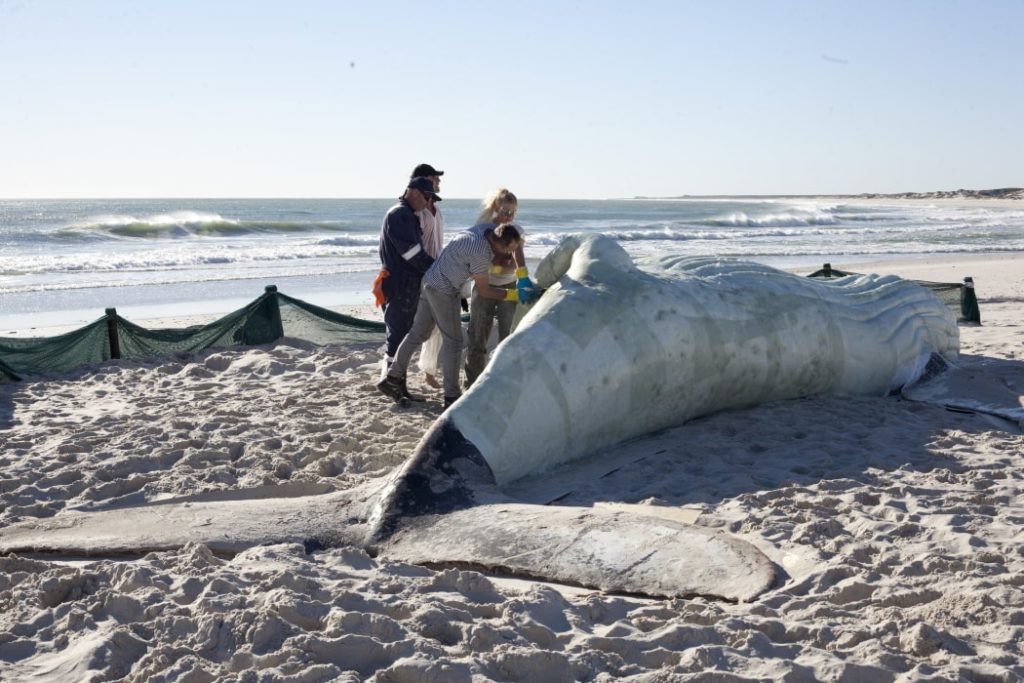
Photo: Warrick Mc Leod, courtesy Gil Shachar and Semjon Contemporary
The team immediately started their work to mould the fourteen-metre-long humpback whale. Gil Shachar, coming from Duisburg, joined the team the following day.
With ten helpers and in only two and a half days, the sand around the whale was first removed and straightened as far as possible. Then a temporary fence was erected to prevent the animal from being pulled back into the open sea by the incoming tide.
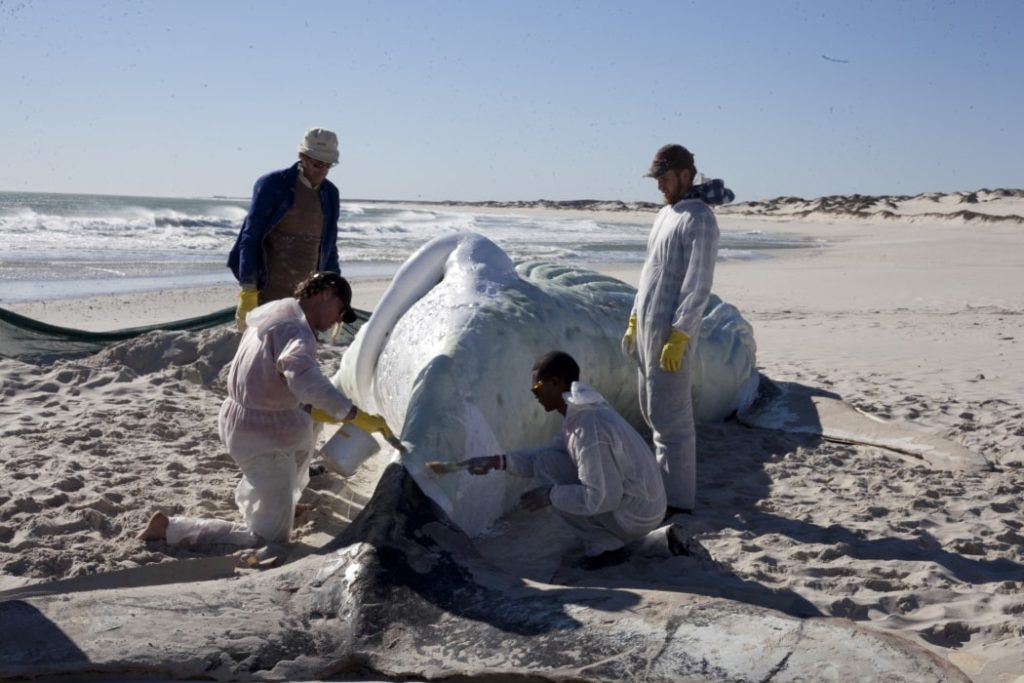
Photo: Warrick Mc Leod, courtesy Gil Shachar and Semjon Contemporary
Thus protected, the moulding of the whale began: first with a layer of gelcoat, then with two layers of glass-fibre reinforced polyester resin.
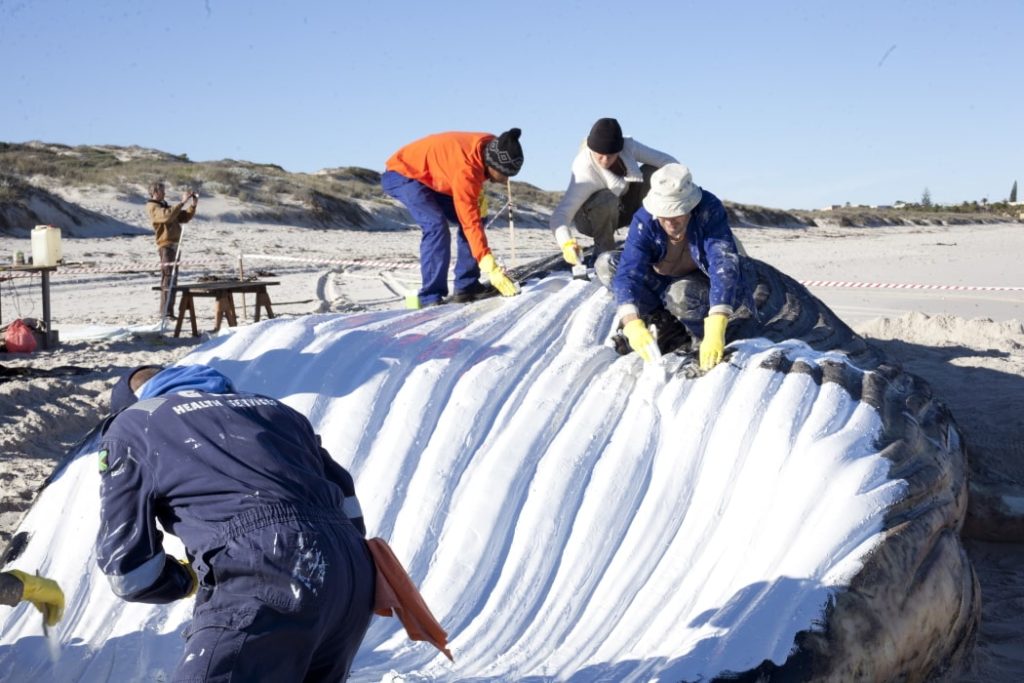
Photo: Warrick Mc Leod, courtesy Gil Shachar and Semjon Contemporary
The hardened mould was then disassembled with the flex and metal hooks were placed at the joints to make it easier to reassemble later. The moulding took three days.
Shortly afterwards, the whale was ‘retrieved’ from the sea.
The whale sculpture itself was later completed in a three-month working process in Cape Town and then shipped to Germany.
Stephan Berg, artistic director of the Kunstmuseum Bonn, writes about this in a text from 2020:
“The search for a workshop where the further steps could take place proved difficult, as the possible location in Cape Town was still occupied at the time. It was only about six months later, in March 2019, that work on the whale could be continued. First with four, then with a total of six helpers, the mould was reassembled and suspended from the ceiling. The seams at the flexed areas were repaired, then the entire mould was laminated with polyurethane.
Several layers of epoxy resin, reinforced with glass fibre mats, and a metal structure integrated into the sculpture provided the necessary stability. In the final step, the sculpture, now consisting of five parts, was painted with a dark, monochrome colour that had to be solvent-based to adhere to the polyurethane. As a result, Shachar used a paint mixture that contained mainly black, non-glossy school board varnish. All in all, these steps took ten weeks.
These indeed exhausting and laborious steps on the way to the final project have been described in more detail here, not least because they stand in great contrast to the matter-of-factness with which this work appears before us: as a given that, now that it is in the world, seems as if it had always been there. And at the same time it triggers a moment of being overwhelmed and deeply touched. The encounter with the cast of this humpback whale is overwhelming by its size alone. The fourteen-metre-long sculpture cannot be completely overlooked from any normal viewing position. That would require a bird’s eye view. But if you approach this colossus at eye level, so to speak, it becomes a mountain range that can only be circled but not grasped in a single glance. (…) Only gradually, when the gaze, which seeks the whole but cannot survey it, approaches the individual parts of the sculpture, does the abstract, huge sculpture become the body of the largest mammal on earth. This is the moment when the overwhelming effect of the sheer monumentality of the sculpture is transformed into a feeling of being touched, when the abstract also becomes an emotional experience. The closer you get to this body, the less you can avoid its corporeality, its orifices, the apparent gaze of the eye, the gashes and wounds inflicted on it by, among other things, ship’s propellers. Perhaps this is the greatest quality of this work: that it is both pure sculptural reality and a highly emotional allegory of creative life par excellence.”
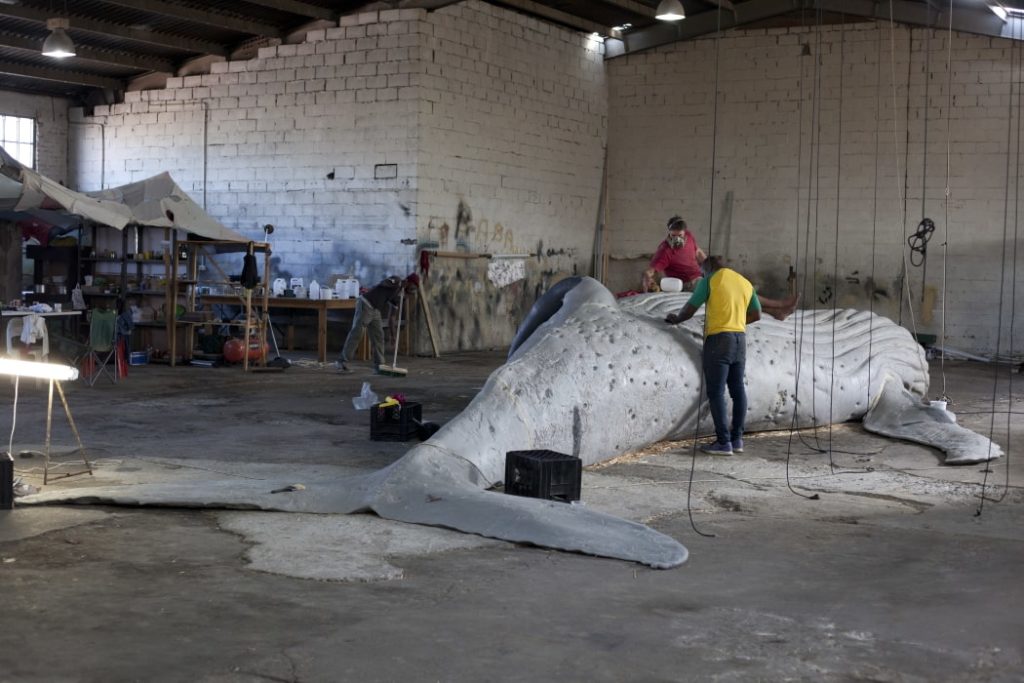
Photo: Warrick Mc Leod, courtesy Gil Shachar and Semjon Contemporary
Many people have already been able to see the large whale at the Bochum Art Museum in 2020, despite Corona. “The encounter with this enormous and impressive sculpture leaves its mark,” says gallery owner Semjon H.N. Semjon. He had also experienced it and quickly realised that in Berlin the ideal place to present the whale sculpture would be the Schinkel Church of St. Elisabeth in Invalidenstraße in Berlin-Mitte. “The proportions of the architecture and the whale are harmonious. In addition, the tragic history of the place, but also its hopeful new beginning after the war and after reunification through countless cultural events, excellently reflects the ‘resurrection’ of the whale, its new life as a work of art,” says the gallery owner.
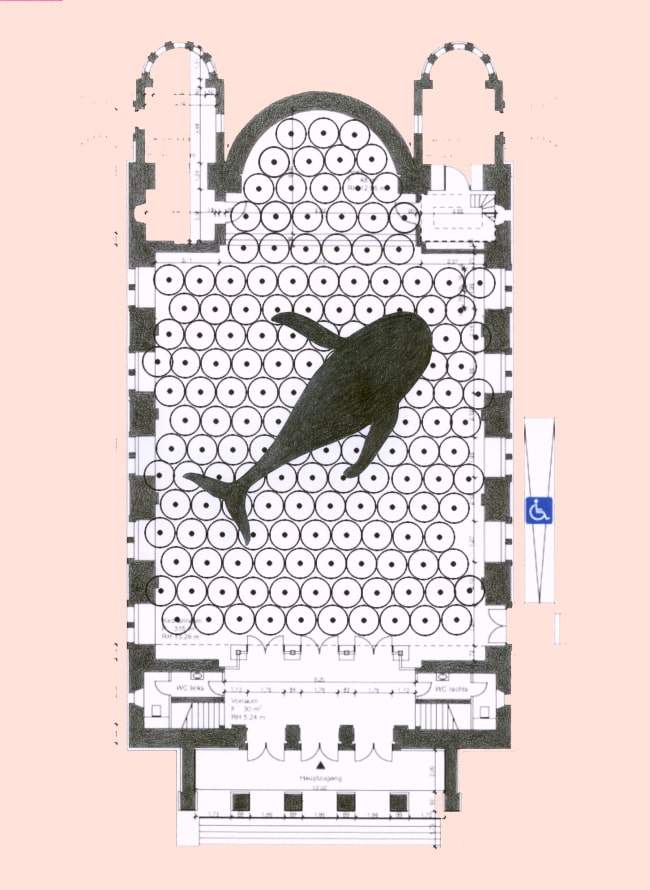
Fine Art Print onHahnemühle Paper Rag; Edition 200 (+20)
(*the circles are distance circles drawn in to find out how many people are allowed to stay according to the rule; after Gil Shachar drew in the whale, the gallery Semjon Contemporary produced the image as an edition print)
Semjon puts into words what the artwork means to him: “The sculpture becomes an ambassador for the battered creature and for how we treat our earth and its creation. Likewise, the many myths that have been spun around it by all peoples are inscribed in our collective memory. The story of Jonah and the whale is familiar to all, Moby Dick as a modern myth even more so. The whale is also a fascinating – seemingly realistic – yet abstract sculpture. A masterpiece by Gil Shachar!”
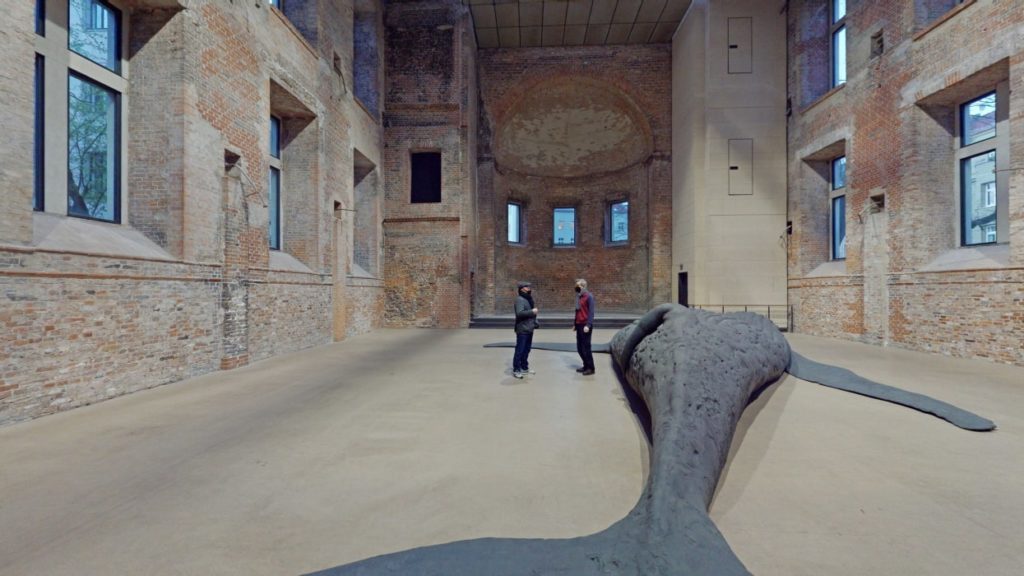
Photo: Artland, Sarah Kivi, by courtesy of the artist and Semjon Contemporary
The fact that the sacred place is now an open house during the Corona pandemic, independent of regulated public life, is proving to be very fortunate in the current situation. In the large nave, the remaining space not occupied by the whale sculpture should actually hold around 150 people, according to the organisers. However, when planning the event, the permitted number of visitors was significantly reduced – to 50 people at a time – to be on the safe side. A negative COVID 19 test is not compulsory for admission, but it is recommended. Those who wish to follow this recommendation in solidarity will find the next test centre in the Villa Elisabeth right next door.
The project can be funded via www.betterplace.me/wal-von-gil-shachar-in-st-elisabeth.
Gil Shachar: Cast Whale Project
WHERE? Offene Kirche St. Elisabeth, Invalidenstraße 3, Berlin-Mitte
WHEN? Donnerstag, 22. April – Freitag, 14. Mai 2021, täglich 11 – 20 Uhr
COSTS? kostenlos
Admission rules: FFP 2 mask mandatory, limited to 50 people in the room at one time, COVID 19 test recommended but not mandatory


